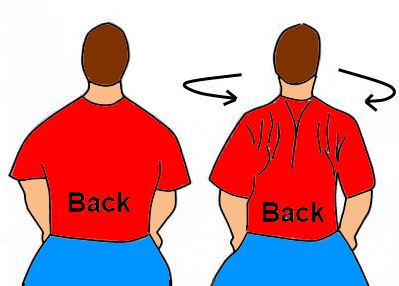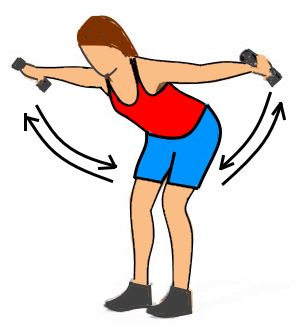5 Exercises That Will Un-Slouch Your Back To Correct Bad Posture And Fix Back Pain

Good posture is as important as eating right, exercising, getting a good night’s sleep and avoiding harmful substances. Without good posture, you can’t really be physically fit and over time your poor posture will cause you to develop problems such as a painful back, aching neck and shoulders, joint pain and it will also have negative effect on your knees. Not standing and sitting up straight can set you up for some surprising health problems such as tension headaches, fatigue, reduced lung function, gastrointestinal pains and it also makes you look older than you are.
The benefits of good posture may be among the best kept secrets and it’s also one of the 70 habits featured in my e-book 70 Powerful Habits For A Great Health which will guide you how to take positive steps to improve your wellness and overall health. But the good news is that almost everyone can avoid the problems caused by bad posture and you can make improvements at any age.
Several different muscles are responsible for maintaining upright posture, and over time, poor posture can cause these muscles to lose strength. In this article I will show you simple exercises that will enable you to strengthen these muscles in order to develop and maintain good posture.
How To Assess your posture
Stand sideways to a full-length mirror. Close your eyes, bend forward, then stand up quickly and gaze at the mirror to check your posture. Are your shoulders slumped? Is your head tilted forward? Does your chest have the appearance of being caved in as if someone just punched you in the sternum? Is your lower back flat or excessively arched?
Ideally, your posture would be considered good if you have a straight back, squared shoulders that are not rounded, eyes looking straight ahead, chest out and stomach tucked in. It’s like drawing a straight line from your ears through your shoulder, hip, knee, to the middle of your ankle (see the illustration below). But most often this is not the case. Weak muscles and sitting many hours on your office chair take their toll.
Now turn and face directly to the mirror to check your posture for symmetry. Is your head tilted to one side? Are your shoulders misaligned? Are your hips misaligned? Are your knees lined up? Your head should not be tilted to the side, shoulders and hips should be aligned and knees should be lined up.
How To Improve Your Posture
1. Strengthen your Neck
A good posture is when your ears are positioned above your shoulders, but have you noticed that when you sit in front of your computer or drive your car, most of the times your head is pushed forward ? Forward head posture is a very common postural issue, this is due to weak and tight areas in your neck that make it hard for you to hold your head straight.
Awareness of the correct neck and shoulder posture is the first step toward correction. A great way to start correcting poor neck posture is through exercises which are designed to help gain control over postural neck muscles which have become weak and fatigued over time.
Chin Tuck Exercise
To bring our neck and head back to proper alignment, do the chin tuck exercise while sitting straight on a chair without tipping your head in any direction. Pull your chin and head straight back. You will feel a stretch at the back of your neck. Relax the chin back forward to a neutral position. Repeat several times. You can do this exercise throughout the day to maintain good posture, so when driving your car, pull your chin in and push your head so it touches the headrest behind you. Do the same exercise when you sit in front of the computer.
Stretch Your Neck (Neck Extension)
Another exercise that can improve your posture in neck extension – drop your chin down towards your chest (moving only your head). Hold for several seconds and release. Repeat several times a day.
2. Strengthen Your Shoulders
It is very common to find ourselves sitting or walking with rounded shoulders. In this position our chest and shoulder muscles become tight and shorter and our upper back is weaken. When you strengthen your upper back, your shoulders will naturally pull back and your chest will open up.
Shoulder Blade Stretches
Sit on a chair or a stool while maintaining good posture, then pull your shoulder blades backwards. Hold for a few seconds and then relax. Repeat several times.
Dumbbell Reverse Flys
Slightly bend your knees and lean over so your chest is slightly above your knees. Start with your hands and dumbbells to your sides. Raise your arms and dumbbells to your side, bringing them up to shoulder level height. Keep your arms as straight as possible but do not lock your elbows. Slowly lower the dumbbells back to the starting position. Do 2-3 sets of 8 repetitions.
3. Strengthen Your Core muscles
Your core muscles include the abdominals (abs) which are at the front of the abdomen, the obliques which are located on the side of the upper body that assist in turning the body from side to side, your lower back and hips. You need to strengthen these muscles in order to have an upright posture. By strengthening these muscles you will also improve your balance ans stability as your core stabilizes your body, allowing you to move in any direction, even on the bumpiest terrain, or stand in one spot without losing your balance
Front Bridge exercise
This exercise is great for strengthening you core muscles. Suck your belly button and keep your body as straight as possible without locking your knees. Continue to breath and don’t hold your breath. Hold yourself in this position as long as you can, then rest. Repeat 2-3 times. Gradually extend the time of holding yourself in the position.
Side plank
Lie on your right side, with straight legs, resting on your right forearm. Your elbow should be directly under your shoulder. Gently contract your abdominals and lift your hips off the floor, maintaining straight line. Keep your neck in line with your spine. Hold 20 to 40 seconds and lower. Repeat two to three times, alternating sides. If you find it too difficult, start with bent knees.
Hip lifts
Lie on the floor with your arms by your sides. Your palms facing down and your legs over your hips at 90 degrees. Feet are flexed. Then lift your hips off the floor using your core muscles while your legs are reaching towards the ceiling. Then return to the starting position. Repeat 15 times.
2. Get used to tuck your tummy in when walking and sitting.
There are many more exercises that will enable you to strengthen your back and your core. I have written in the past about exercises to strengthen your back and about exercises to get flat tummy that you can easily do at home. Start to integrate these exercises into your daily routine. Don’t do all of them at once, but each time choose a few different exercises to do each day.
4. Strengthen Your Hips
A good posture is when our hips are neutral and level when viewed from the side, but sometimes when we stand, our hips are tilted forward (forward pelvic tilt). It is therefore important to strengthen your thighs, butt and hip flexor muscles which allow you to lift your knees and bend at the waist.
Kneeling lunge stretch
This exercise stretches the muscles between the front of your thigh and the lumber vertebrae which are called hip flexor muscles. These muscles can pull the spine out of alignment if they are too tight. Position yourself as per the illustration while keeping yourself upright and not leaning forward. Stretch the front of your upper thigh but keep your hips even. Hold for few seconds and repeat on the other side.
Bend knee to chest
This exercise is for the low back and stretches your hip muscles. Lie down on the floor and pull your knee towards your chest while keeping your tailbone on the floor. Hold each stretch for few seconds and repeat 3 times for each side.
Raise your hips
5. Knees
Your knees can also help you to maintain healthy posture – here are two useful tips:
1. Keep your knees slightly bent and shoulder-width apart. Make sure that your weight is evenly distributed on your feet.
2. When lifting heavy load off the floor, always bend your knees and not your back. Keep your belly tucked in. Bending your back can cause a back injury as your back muscles are not designed for taking such a heavy weight, but the muscles in your legs and stomach are large enough to carry it.
There is no magic solution for fixing poor posture other than consistency, awareness and exercising. It will probably feel unnatural initially, but developing good posture doesn’t happen overnight. As time goes on, you will develop good postural habits, and it will come more naturally to you. Try it for yourself: stand straight in front of a mirror and see how taller, leaner and more confident you look when you maintain good posture.
If you suffer from back pain or just want to prevent back pain – I have great exercises for you in my article about the top 13 exercises to strengthen your back and reduce back pain (including detailed illustrations). If you are interested to get rid of Jiggly arms – read my post:












